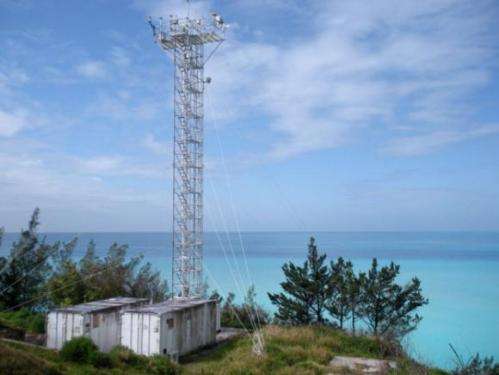Researchers track ammonium source in open ocean

To understand the extent to which human activities are polluting Earth's atmosphere and oceans, it's important to distinguish human-made pollutants from compounds that occur naturally. A recent study co-authored by a Brown University professor does just that for ammonium, a compound that is produced by human activities like agriculture, as well as by natural processes that occur in the ocean.
The research, based on two years of rainwater samples taken in Bermuda, suggests that ammonium deposited over the open ocean comes almost entirely from natural marine sources, not from anthropogenic sources.
"That was a bit of a surprise," said Meredith Hastings, the Joukowsky Assistant Professor of Earth, Environmental, and Planetary Sciences and one of the study's co-authors. "We have some sense of what the ammonium emissions are in the United States, so we would expect to see that signature in Bermuda, but we don't see it."
The findings, published in Global Biogeochemical Cycles, don't necessarily mean that ammonium emissions are lower than was previously thought, Hastings said. It could be that the ammonium is simply deposited closer to the continent before it reaches Bermuda, which is about 600 miles of the coast. Either way, the findings suggest that humans are not adding nearly as much ammonium to the ocean as some researchers had assumed.
Understanding the human contribution of ammonium is important because ammonium is a source of nitrogen. Too much nitrogen added to rivers and oceans can disrupt aquatic ecosystems.
"We see a lot of deleterious effects of increased nitrogen pollution on our waterways and our drinking water," said Hastings, who is also a fellow in Brown's Institute for the Study of Environment and Society. "So if you want to make policy to limit emissions and reduce these pollution impacts, we need to have a good handle on what sources are natural and what are anthropogenic."
An ideal testing ground
The island of Bermuda is an ideal place to study the origins of pollutants, Hastings said. The weather over the island is dominated by tropical air masses that blow in from the south. But for part of the year, when tropical high pressure shifts, air masses coming off the continental United States work their way into the region. Those air masses can contain pollutants from industry, agriculture and other human activities on the continent.
"It's a really nice setup where we have these different air masses at different times of the year," Hastings said. "We can separate what's coming in from anthropogenic continental sources and what's coming in from natural marine sources."
Over two years, the researchers collected rain samples and matched each sample with air mass history data supplied by the National Oceanic and Atmospheric Administration. They then tested the samples, looking for the amount of ammonium in each sample. They also looked for specific isotopes of nitrogen in the ammonium (the molecule is made from one nitrogen atom and four hydrogen atoms). Compounds from different sources often have different isotopes of certain elements, so scientists can use them as a tracer.
The researchers found that, regardless of air mass, the samples had generally the same amount of ammonium and the same nitrogen isotopes. There was no clear signal of an anthropogenic source for the ammonium, even when continental air masses entered the region. Using a model of the exchange of ammonia from the ocean to the atmosphere, the researchers were able to explain the amount of ammonium and the nitrogen isotopes in the rainwater using only marine sources.
The results were in stark contrast to research done by the same team looking at nitrate, another nitrogen-based pollutant, in Bermuda. For nitrate, there was a very clear signal in the isotope data of anthropogenic sources coming in from the continent.
"We expected to see the same thing with ammonium," Hastings said, "and I think it's pretty surprising that we didn't."
Emissions of nitrate, which are linked largely to the burning of fossil fuels, are much better studied than ammonium, Hastings said. As policymakers work to curb fossil fuel emissions, other sources of nitrogen, including ammonium, may become more important.
"That's one of my interests in using this isotope tool," Hastings said. "We want to see if we can track all of these different sources of nitrogen to see if they're man-made or if they're natural. That helps us to understand what perturbations humans are having on natural systems."
Journal information: Global Biogeochemical Cycles
Provided by Brown University




















